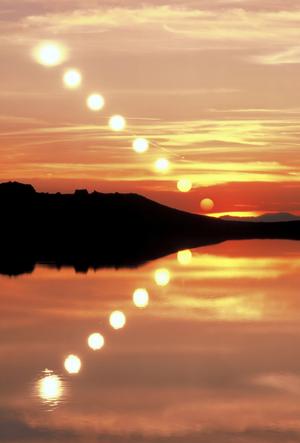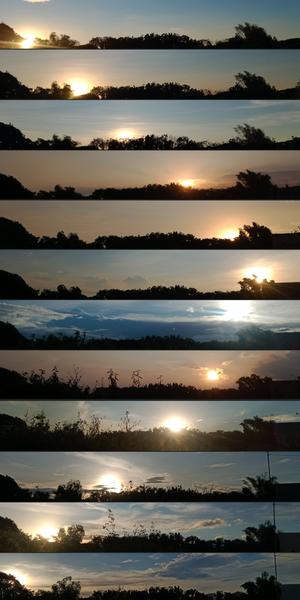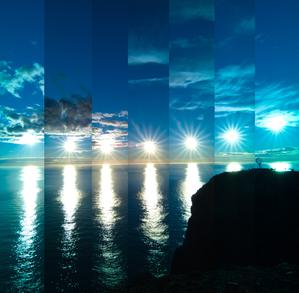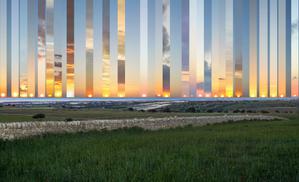Glossarbegriffe: Sonnenbahn (Tagbogen)
Description: Die Sonnenbahn oder der Tagbogen zeichnet die scheinbare Bewegung der Sonne am Himmel nach, wie sie von einem Beobachter an einem festen Standort auf der Erde gesehen wird. Jeden Tag beschreibt die Bahn einen Bogen, der mit dem Sonnenaufgang im östlichen Teil des Himmels beginnt und mit dem Sonnenuntergang im westlichen Teil endet. Nur zur Frühlings- und Herbsttagundnachtgleiche geht die Sonne genau im Osten auf und genau im Westen unter. Zur Wintersonnenwende ist der Bogen am kürzesten und am tiefsten am Himmel. Von da an nimmt die Länge dieses Bogens und damit die Länge des Tages zu. Jeder weitere Bogen ist höher am Himmel als der vorherige, bis er zur Sommersonnenwende seine maximale Höhe und Tageslänge erreicht. Dieser Prozess wiederholt sich dann in umgekehrter Reihenfolge und erreicht zur Wintersonnenwende wieder den kürzesten, niedrigsten Bogen.
Nördlich des nördlichen Polarkreises und südlich des südlichen Polarkreises geht die Sonne im Winter nicht für längere Zeit auf und im Sommer nicht für längere Zeit unter. Daher kann es dort im Winter Nächte und im Sommer Tage geben, die mehrere Monate dauern. Während einer dieser Polartage wandert die Sonne in einem Kreis um den Himmel und bewegt sich von einem Hochpunkt zur Mittagszeit zu einem Tiefpunkt um Mitternacht, ohne jemals den Horizont zu überqueren.
Die Tagbögen der Sonne können in einem Langzeitbelichtungsbild, einem sogenannten Solargraph, festgehalten werden.
Zugehörige Glossarbegriffe:
See this term in other languages
Term and definition status: The original definition of this term in English have been approved by a research astronomer and a teacher The translation of this term and its definition is still awaiting approval
The OAE Multilingual Glossary is a project of the IAU Office of Astronomy for Education (OAE) in collaboration with the IAU Office of Astronomy Outreach (OAO). The terms and definitions were chosen, written and reviewed by a collective effort from the OAE, the OAE Centers and Nodes, the OAE National Astronomy Education Coordinators (NAECs) and other volunteers. You can find a full list of credits here. All glossary terms and their definitions are released under a Creative Commons CC BY-4.0 license and should be credited to "IAU OAE".
Zugehörige Medien
The Last Hour of the Day
Bildnachweis: Fabrizio Melandri/IAU OAE (CC BY 4.0)
License: CC-BY-4.0 Creative Commons Namensnennung 4.0 International (CC BY 4.0) icons
Where the Sun Sets Every Month
Bildnachweis: John Paul Pile/IAU OAE (CC BY 4.0)
License: CC-BY-4.0 Creative Commons Namensnennung 4.0 International (CC BY 4.0) icons
The Eclipse Clock-Eclipse on a Polar Day
Bildnachweis: Stephanie Ziyi Ye/IAU OAE (CC BY 4.0)
License: CC-BY-4.0 Creative Commons Namensnennung 4.0 International (CC BY 4.0) icons
When the Sun Bounces
Bildnachweis: Milos Obert/IAU OAE (CC BY 4.0)
License: CC-BY-4.0 Creative Commons Namensnennung 4.0 International (CC BY 4.0) icons
The Path of the Sun
Bildnachweis: Frank Niessen/IAU OAE (CC BY 4.0)
License: CC-BY-4.0 Creative Commons Namensnennung 4.0 International (CC BY 4.0) icons
Solstices and Equinox
Bildnachweis: Tunç Tezel/IAU OAE (CC BY 4.0)
License: CC-BY-4.0 Creative Commons Namensnennung 4.0 International (CC BY 4.0) icons
Occasive Amplitude
Bildnachweis: Marcella Giulia Pace/IAU OAE (CC BY 4.0)
License: CC-BY-4.0 Creative Commons Namensnennung 4.0 International (CC BY 4.0) icons















